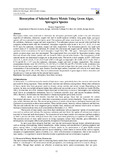| dc.description.abstract | Biosorption studies were conducted to determine the adsorption parameters (pH, contact time and adsorption capacity) of cadmium, chromium, copper and lead in model aqueous solutions using green algae, spirogyra species. pH was optimized for each heavy metal. The optimum pH values were found to be 5.5, 5.8, 5.9 and 5.0 for cadmium, chromium, copper and lead, respectively. The adsorption process was second order and fitted the Langmuir isotherm better than the Freundlich. Adsorption capacities were found to be 22.52, 38.19, 35.59 and 94.34 mg/g for cadmium, chromium, copper and lead, respectively. The biosorption process was rapid with contact times of 15 minutes for cadmium, 40 minutes for chromium and copper and 50 minutes for lead. The optimum initial concentrations for metal adsorption ranged from 500 - 700 µg/mL. Adsorption kinetics of the metals on green algae were also investigated. The experimental data was tested for biosorption kinetics using first and second order kinetic models and was found to follow second order kinetics. The concentration of the selected metals was determined in algae and in the parent water. The results in both samples by ICP – OES were 1.81 ± 0.11, 64.33 ± 0.35, 17.14 ± 0.155 and 12.08 ± 1.80 µg/L in water and 2.30 ± 0.09, 12.17 ± 0.20, 25.61 ± 0.74 and 60.50 ± 1.57 µg/g for cadmium, chromium, copper and lead in algae, respectively. The average concentration factors were Cd (2547.01), Cr (367.02), Cu (1843.59) and Pb (7154.95). Little correlation was found between the heavy metal concentration in parent water and in algae from the same water (R ≤ 0.32). The concentration of the acid-leached metal fraction from the algal surface, correlated well with the total metal taken up by the algae, (0.55 ≤ R ≤ 0.94). This work demonstrates the potential of green algae as both a biosorbent and bioindicator of water pollution by the selected heavy metals | en_US |

